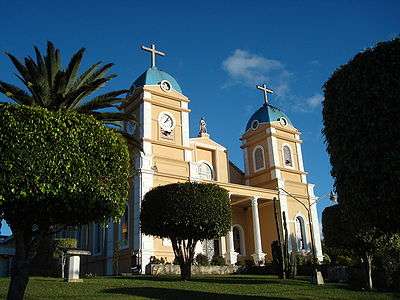San Marcos, Costa Rica
San Marcos or San Marcos de Tarrazú is the capital city of the canton of Tarrazú in the province of San José in Costa Rica. It is also the name of the distrito (district) that includes the city. The district of San Marcos covers an area of 42.07 km²,[1] and has a population of 8,817.[2]
The city lies at an elevation of 1,429 meters above sea level[1] in a mountainous area known as Los Santos, 70 kilometers south of the national capital city of San José.
History

The city was founded in the 1820s by agricultural migrants from the Central Valley. The region's earliest residents were dedicated to growing basic foodstuffs, namely beans, corn, and sugar cane. Local farmers started growing coffee in the highland valley in the 1890s. The region is best known for its high quality coffee.
Geography
San Marcos de Tarrazu is located in the north bank of the Pirris River, in a highland valley surrounded by mountains that are part of the Talamanca Sierra in southern Costa Rica. Downtown San Marcos is 1350 meters above sea level but is surrounded by peaks as high as 3000 meters above sea level.
Its geography is suited to growing coffee, mostly because the slopes of the mountains face the morning light and the cloud cover protects the coffee trees in the afternoon. The red soil found in the valley is of volcanic origin. All this plus the altitude make ideal conditions to grow the coffees harvested by locals.
-

Downtown San Marcos de Tarrazu - Catholic Church in the background
-

Concepcion de Tarrazu highlands near Quepos Port, Costa Rica
-

Naranjillo de Tarrazu, as seen from Concepcion, near Port Quepos
-

Coffee fields Quebrada Honda de Tarrazu
-

Downtown San Marcos de Tarrazu National bank branch to the left and the popular "Bar El Banco" to the right, in a busy December afternoon
Politics
The Tarrazú county or canton is divided in three districts: San Marcos de Tarrazu, San Lorenzo, and San Carlos. The first district is the commerce center of the entire valley. This region has a deep-seated political relationship with the Liberacion Nacional political party that stems back to the 1948 Civil War. Jose "Pepe" Figueres and his troops were not only headquartered in the neighboring community of Santa Maria de Dota, but the main concentration camp of political prisoners for these forces was housed in San Marcos' school. Moreover, a vast majority of Figueres' foot soldiers were from the present-day cantons of Tarrazu, Dota, and Leon Cortes. Furthermore, most of Figueres' workers at his cabuya hacienda, "La Lucha Sin Fin," were from this same region.
Economy
Traditionally, cultural and economic progress have been directly tied to the coffee industry. More recently, however, other agricultural products, namely avocados, have helped farmers keep afloat in years of coffee decline. Perhaps the key reason this region has managed to retain its coffee production, while other regions in Costa Rica have been unable to do so has been immigration. Indeed, since the 1960s this region has exported a considerable percentage of its workforce to the United States.
Flora and fauna
The district of San Lorenzo has been almost overlooked by coffee farmers mostly because of its lowlands and tropical weather. However, more recently tourism has flourished thanks to its pristine forests and clean rivers, the proximity to the Quepos plains and Manuel Antonio National Park. Giant pre-historic ferns and hardwoods can be found here. Birds such as the Quetzal and small mammals are abundant.
Demographics
The city of San Marcos, located in the highland valley of Tarrazu, has a population of approx. 12,000 people. The majority of its people grow coffee in the mountains surrounding the city. San Marcos de Tarrazu has been known in the green coffee trade industry as a source of coffee beans. Nearby towns of Santa Maria and San Pablo are also sources of specialty coffee beans. Roman Catholics comprise approx. 90% of the local population. Due to coffee picking, Nicaraguans and Panamanian Indians are settling in the valley in record numbers.
Culture
Local culture varies little from that of the rest of Costa Rica, in that the Catholic Church and the Costa Rican state both play a critical role in determining days of celebration. Indeed, the annual Patron Saints' Day Festival is both a civic and a religious event. Whereas much of Costa Rica has allowed the cultural importance of coffee production to decline, this region is deeply wedded to this crops' production. This is evident in the fact that a majority of the region's children continue to pick coffee, a custom that has largely gone out of fashion in the Central Valley where coffee picking is almost entirely done by foreign laborers, namely Nicaraguans. The region has a number of bars, dance halls, and brothels but few other spaces for leisure activity.
References
Coordinates: 9°40′N 84°02′W / 9.667°N 84.033°W